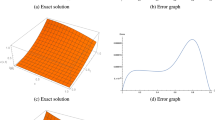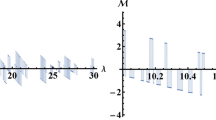Abstract
The closed form solutions of differential–difference equations arising from mathematical models of granulocytopoiesis, both with and without maturing cells, are presented. The model with maturing cells, which we call model I, is considered first. The solution technique consists of a Laplace transform approach that converts each of the two differential–difference equations to a difference equation in the transform domain, and subsequent Laplace transform inversion of the solution to express it in the time domain. The model without maturing cells, which we call model II, is next considered and is solved by a method similar to that for model I. From these solutions, useful information and properties, like average number of active and maturing cells, and the transient growth and half-life periods of cells in each stage, can be obtained analytically. This information can play a very crucial role in the treatment of granulocytopoiesis. Further, the numerical solution of another model, which we call model III, for describing the dynamics of imatinib (drug used to treat certain types of cancer)-treated chronic myelogenous leukemia is discussed using a wavelet adaptive computational approach.




Similar content being viewed by others
References
Cronkite, E.P., Vincent, P.C.: Granulocyteopoiesis. In: Stohlman, F. (ed.) Hemopoietic Cellular Proliferation. Grune and Stratton, New York (1970)
Maloney, M., Patt, H.M.: Granulocyte transit from bone marrow to blood. Blood 31, 195–201 (1968)
Ahmed, E., Hegazi, A.S., Elgazzar, A.S.: On difference equations motivated by modelling the heart. Nonlinear Dyn. 46, 49–60 (2006)
Izzo, G., Vecchio, A.: A discrete time version for models of population dynamics in the presence of an infection. J. Comput. Appl. Math. 210, 210–221 (2007)
Fokas, A.S., Keller, J.B., Clarkson, B.D.: Mathematical model of granulocytopoiesis and chronic myelogenous leukemia. Cancer Res. 51, 2084–2091 (1991)
Cronkite, E.P., Vincent, P.C.: Granulocyteopoiesis. Ser. Haematol. 2, 3–43 (1969)
Rubinow, S.I.: A simple model of steady state differentiating cell system. J. Cell Biol. 43, 32–39 (1969)
Rubinow, S.I., Lebowitz, J.L.: A mathematical model of neutrophil production and control in normal man. J. Math. Biol. I, 187–225 (1975)
Whittaker, J.A.: Leukemia. Blackwell Scientific Publisher, Oxford (1968)
Druker, B.J., Lydon, N.B.: Lessons learned from the development of an abl tyrosine kinase inhibitor for chronic myelegenous luekemia. J. Clin. Investig. 105, 3–7 (2000)
Campbell, J.D., Cook, G., Holyoake, T.L.: Evolution of bone marrow transplantation-the original immunotherapy. Trends Immunol. 22, 88–92 (2001)
Wheldon, T.E., Krik, J., Finlay, H.M.: Cyclical granulopoiesis in chronic granulocytic leukemia: a simulation study. Blood 43, 379–225 (1974)
Loeffler, M., Wichmann, H.E.: A comprehensive mathematical model of stem cell proliferation which reproduces most of the published experimental results. Cell Tissue Kinet. 13, 543–561 (1980)
Neiman, B.: A Mathematical Model of Chronic Myelogenous Leukemia. Oxford University, Oxford (2000)
Moore, H., Li, N.K.: A mathematical model for chronic myelogeneous leukemia (CML) and T cell interaction. J. Theory. Biol. 225, 513–523 (2004)
Kim, P.S., Lee, P.P., Levy, D.: Modelling imatinib-treated chronic myelogeneous leukemia: reducing the complexity of agent-based models. Bull. Math. Biol. 70, 728–744 (2008)
Kim, P.S., Lee, P.P., Levy, D.: A PDE model for imatinib-treated chronic myelogenous leukemia. Bull. Math. Biol. 70, 1994–2016 (2008)
Liandrat, J., Tchamitchian, P.: Resolution of the 1d Regularized Burgers Equation Using a Spatial Wavelet Approximation. Technical Report , pp. 90–83, ICASE, (1990)
Vasilyev, O.V., Bowman, C.: Second generation wavelet collocation method for the solution of partial differential equations. J. Comput. Phys. 165, 660–693 (2000)
Mehra, M., Kevlahan, N.K.-R.: An adaptive wavelet collocation method for the solution of partial differential equations on the sphere. J. Comput. Phys. 227, 5610–5632 (2008)
Aldroubi, A., Unser, M.: Wavelets in Medicine and Biology. CRC press, Boca Raton (1996)
Mallik, R.K.: Solutions of linear difference equations with variable coefficients. J. Math. Anal. Appl. 222, 79–91 (1998)
Mallik, R.K.: On the solution of a linear homogeneous difference equation with variable coefficients. Siam J. Math. Anal. 31, 375–385 (2000)
Blumenson, L.E.: A comprehensive modelling procedure for the human granulopoietic system: over-all view and summary of the data. Blood 42, 303–312 (1973)
Roeder, I., et al.: Dynamic modeling of imatinib treated cml: functional insights and clinical implications. Nat. Med. 12, 1181–1184 (2006)
Jameson, L.: On the Wavelet-Optimized Finite Difference Method. ICASE CR-191601 (1994)
Kumar, V., Mehra, M.: Wavelet optimized finite difference method using interpolating wavelets for self-adjoint singularly perturbed problems. J. Comput. Appl. Math. 230, 803–812 (2009)
Michor, F., Hughes, T.P., Iwasa, Y., Branford, S., Shah, N.P.: Dyanmics of chronic myeloid leukemia. Nature 435, 1267–1270 (2005)
Author information
Authors and Affiliations
Corresponding author
Rights and permissions
About this article
Cite this article
Mehra, M., Mallik, R.K. Solutions of Differential–Difference Equations Arising from Mathematical Models of Granulocytopoiesis. Differ Equ Dyn Syst 22, 33–49 (2014). https://doi.org/10.1007/s12591-013-0159-5
Published:
Issue Date:
DOI: https://doi.org/10.1007/s12591-013-0159-5




